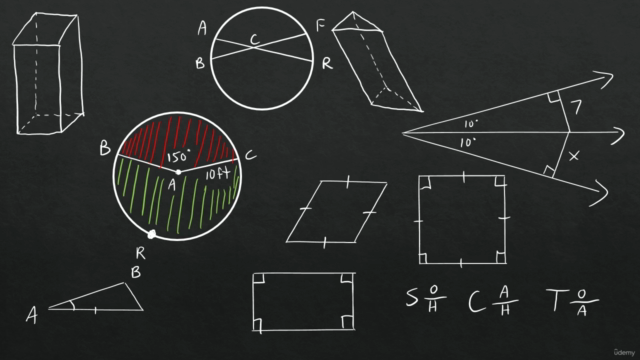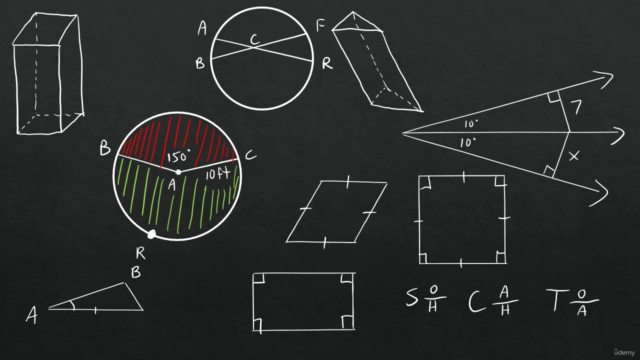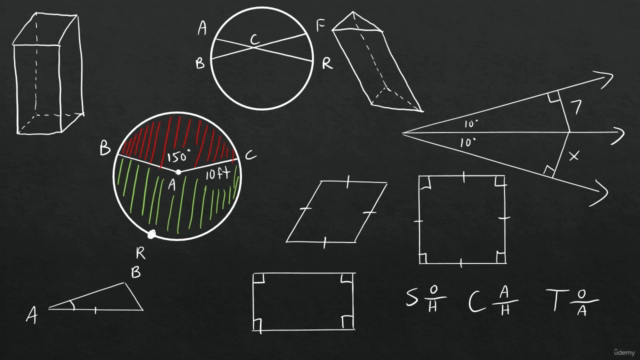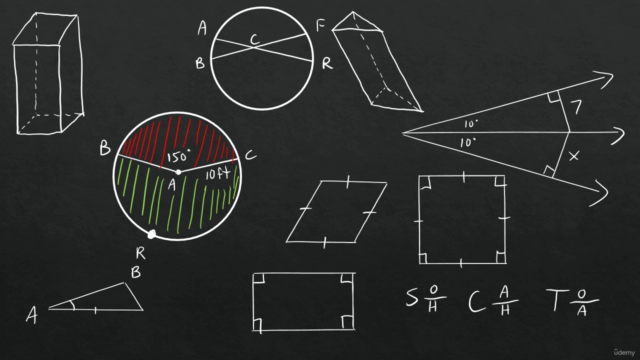Geometry Made Simple!

Why take this course?
Based on the outline provided, it seems you are looking to cover a comprehensive curriculum in geometry, which includes a variety of topics from understanding right triangles and trigonometry to measuring lengths, areas, and volumes of different geometric solids. Here's a breakdown of the topics and how you might approach them:
S06 - Right Triangles and Trigonometry
- Pythagorean Theorem: Understand the relationship between the sides of a right triangle (a² + b² = c², where 'c' is the hypotenuse and 'a' and 'b' are the other two sides).
- Converse of the Pythagorean Theorem: Learn that if the ratios of the sides satisfy the equation a²/c² + b²/c² = 1, then the triangle is a right triangle.
- Similar Right Triangles: Study how similar triangles are scaled versions of one another and how their angles and side ratios remain proportional.
- Special Right Triangles: Explore triangles that are commonly found in geometry (e.g., 45-45-90, 30-60-90, and 30-90-90 degrees triangles) and understand their properties and applications.
- Sine, Cosine, and Tangent Ratios: Learn the trigonometric ratios that relate an angle in a right triangle to the lengths of its sides (opposite side/hypotenuse for sine, adjacent side/hypotenuse for cosine, and opposite side/adjacent side for tangent).
- Solve Right Triangles: Apply trigonometry to solve for unknown sides or angles in right triangles.
S07 - Quadrilaterals
- Find Angle Measures in Polygons: Understand how to calculate the measures of interior angles in polygons using the formula (n-2) × 180°, where 'n' is the number of sides.
- Properties of Parallelograms: Study the properties of parallelograms, including congruent adjacent angles, opposite sides parallel and equal in length, diagonals that bisect each other, and the ability to divide into two triangles.
- Show that a Quadrilateral is a Parallelogram: Learn the necessary conditions for a quadrilateral to be a parallelogram (opposite sides must be parallel and equal in length).
- Properties of Rhombuses, Rectangles, and Squares: Explore the special cases of parallelograms: rhombuses (all sides are of equal length), rectangles (opposite sides are of equal length), and squares (all sides are of equal length and all angles are right angles).
- Properties of Trapezoids and Kites: Learn about trapezoids (one pair of opposite sides are parallel) and kites (a pair of adjacent sides are both equal in length, but the diagonals are not necessarily equal).
- Identify Special Quadrilaterals: Differentiate between different types of quadrilaterers based on their properties.
S08 - Properties of Transformations
- Translate Figures and Use Vectors: Understand translations and how vectors can represent movements in a plane.
- Perform Reflections: Learn about reflections across lines and the concept of symmetry.
- Apply Glide Reflections: Explore glide reflections, which are compositions of a translation and a reflection.
- Identify Symmetry: Determine the order of transformations that result in a given symmetry.
S09 - Properties of Circles
- Properties of Tangents: Understand what it means for a line to be tangent to a circle (the line touches the circle at exactly one point, and at that point, all the light that hits the line also hits the circle).
- Arc Measures: Learn how to calculate the measure of an arc based on the measure of its central angle.
- Properties of Chords: Study the properties of chords, including intersecting chords and the perpendicular from the center to a point of intersection (the midpoint segment theorem).
- Inscribed Angles and Polygones: Understand that an inscribed angle's measure is half the measure of its intercepted arc.
- Apply Other Angle Relationships in Circles: Explore other angle relationships within a circle, such as the angles subtended by an arc from two different points.
- Measurement and Area: Calculate the length of arcs, sectors, and segments; and compute the area of sectors and segments of circles.
S10 - Measuring Lengths and Areas
- Lengths in Triangles: Use trigonometry to find lengths of sides in triangles.
- Areas of Triangles: Calculate the area of a triangle given its base, height, or using trigonometric relationships in right triangles.
- Surface Area and Volume of Geometric Solids: Understand and calculate surface area and volume for different geometric solids (e.g., prisms, cylinders, spheres, cones).
- Circumference and Area of Circles: Compute the circumference of a circle using π(d/2) or πd, where 'd' is the diameter, and calculate the area using A = πr², where 'r' is the radius.
S11 - Geometric Probability and Statistics
- Data Collection: Learn how to collect and organize data.
- Descriptive Statistics: Understand measures of central tendency (mean, median, mode) and variability (range, variance, standard deviation).
- Probability: Explore the basics of probability, including conditional probability, independent events, and expected value.
- Statistics: Apply statistical methods to analyze data and draw conclusions.
Enrollment and Resources
To enroll in a course that covers these topics, you can look for high school geometry classes, community college courses, or online learning platforms like Khan Academy, Coursera, edX, or Udemy, which offer geometry courses at various levels of complexity. Remember to choose a course that matches your current skill level and learning goals.
Good luck with your studies in geometry! It's a fundamental subject that underpins much of mathematics and its applications in the real world.
Course Gallery




Loading charts...